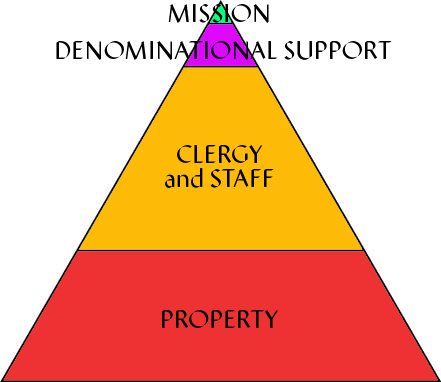There is always the temptation to worship at the altar of big. We all know the big churches in our regions—those flagship congregations that can afford their own picnic grove, gymnasium, sound systems, organs with banks of pipes, air conditioning, three or four pastors and a half dozen support staff. They need tons of people to support this lifestyle. That’s why there are so few large churches!
Regional offices love them, however. It makes them feel successful. They count on a few thousand dollars a month in support from them. Pastors compete for calls to serve them. They become the stepping stones for professional leaders who want to climb the church ladder.
The problem? They reach comparatively few people. Most people belong to small churches with fewer than 300 members.
Large churches grew out of post-war franchise thinking. Before there was a MacDonald’s in every town with a population of 10,000, there was the local hamburger joint or soda counter. That’s where you went for memorable dates or to hangout for hours long after a waiter carried your plate away. That’s where you knew the owner and staff by name. And they knew you, too. And your family.
Hey, let’s centralize our services. We’ll build big churches with bigger parking lots in the suburbs. People will flock to the big churches. We’ll let the little churches die and focus on getting bigger. It will provide more money for mission! That’s our job, right?
So how come there is less money for mission these days? How come the regional bodies are starving for support?
Franchises run on efficiency. You can serve more for less. Most management decisions are already made for you by the franchise owner. The decor. The menu. The salary structure. The hours.
Profit is the goal. Profit is made when people keep moving and present no challenges. Franchise operators don’t need to be leaders. They just need to perform. And customers? There is no expectation of customers beyond stuffing their paper plates in a trash can before they leave. They’ll return to the nearest franchise (it won’t matter which one) the next time they need quick satisfaction for their hunger—not unlike Christmas and Easter Christians.
Church leaders are attracted to franchise thinking. They see themselves as managers. That’s what managers do. They make the bottom line work — for them! The liturgy, the music, the bulletins, worship times, the robes—they’ll be the same. So will the mission opportunities. Streamlined. Efficient.
Franchise mentality only works to a point in church work. We are not selling hamburgers. We are trying to reach people.
People present challenges.
That’s why small churches work. People don’t mind being part of a franchise’s profit base when all they want is a burger with fries, and their need can be satisfied with a $5 bill.
Some problems are harder to solve. People may:
- Be sick or dying.
- Be addicted or poor.
- Be confused.
- Feel broken, lonely or inadequate.
- Feel guilty.
- Long for fulfillment or expression.
- Want to know the people around them and see them again.
- Remember sitting and singing with mom and dad or grandmom and granddad.
- Want their children to be nurtured with good food or sound thinking.
- Need a friend.
- Want more from a staff than an upsale and a stack of napkins.
That’s when they turn to the neighborhood church.
The efficient, centralized church 15 miles away will not attract them. If that is the only option, they’ll look elsewhere to satisfy their needs. It probably won’t be in church.
In the end, they won’t care how many staff there are or about the organ or air-conditioning.
They just want to feel better. They want to know that God, the great franchise owner, cares about them.


![pyramid]2](http://2x2virtualchurch.com/wp-content/uploads/2014/02/pyramid2.jpg)



